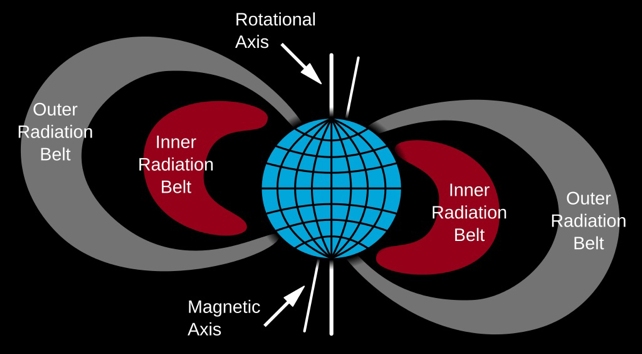2025-02-07 11:46:00
www.sciencealert.com
In May 2024, an epic solar storm rattled Earth so powerfully that its effects were felt even at the bottom of the ocean.
In the wake of a torrent of flare activity on the Sun, our planet was buffeted by a powerful blast of solar particles that shook our magnetic field, and bathed our skies with a panoply of shimmering colors as auroras reached far lower latitudes than usual.
But its effects were way more far-reaching, as scientists now reveal. In the months following the storm, Earth was girded by two new, temporary radiation belts of high-energy particles, trapped by the planet’s magnetic field.
While we’ve seen this phenomenon before – following powerful geomagnetic storms – the solar storm of May 2024 delivered something we had never detected: energetic protons in one of the new belts.
“When we compared the data from before and after the storm, I said, ‘Wow, this is something really new’,” says physicist Xinlin Li of the University of Colorado Boulder. “This is really stunning.”

Radiation belts are a normal part of the architecture of a planet with a global magnetic field. Stars are constantly leaking particles, borne by a stellar wind; these stream out and, where they encounter planetary magnetic fields, become entrapped, forming vast belts in toroidal formation around the planet in the center.
Earth has two permanent radiation belts known as the Van Allen belts, an inner belt closer to the planet, and an outer belt encircling both. This is a good thing; it’s sort of like a planetary defense system that protects our planet from direct bombardment by solar particles, and allows us to live here relatively unscathed.

Since these belts are maintained and replenished by solar particles, it’s unsurprising that an increase in solar particle output, as generated by the flares and coronal mass ejections of a solar storm, would augment what’s already there.
Even so, when the scientists investigated the effects of the solar storm of May 2024 based on data collected by the NASA’s Colorado Inner Radiation Belt Experiment CubeSat, what they saw surprised them.
There, sandwiched between the two Van Allen radiation belts, they found two new belts – one predominantly comprising electrons, as we’ve seen previously, and the other containing energetic protons, which has never been seen before.
“These are really high-energy electrons and protons that have found their way into Earth’s inner magnetic environment,” says astronomer David Sibeck of NASA’s Goddard Space Flight Center, who was not involved with the research. “Some might stay in this place for a very long time.”
frameborder=”0″ allow=”accelerometer; autoplay; clipboard-write; encrypted-media; gyroscope; picture-in-picture; web-share” referrerpolicy=”strict-origin-when-cross-origin” allowfullscreen>
In fact, the belts remained intact for much longer than previous temporary radiation belts generated by solar storms: three months, compared to the weeks we’d normally expect.
Subsequent solar storms in June and August of 2024 knocked most of the particles out of orbit, significantly diminishing the density of the belts. A small amount, however, still remains up there, hanging out with Earth.
What’s more, the proton belt may remain intact for over a year. Ongoing measurements will help scientists measure its longevity and decay rate.
This is important information to have: particles in Earth orbit can pose a hazard to satellites hanging out up there, so knowing the particle density and the effects solar storms can have thereon can help engineers design mitigation strategies to protect our technology.
At the moment, though, the hazard posed by the new radiation belts is unquantified. Future studies will be needed to determine the risks these, and future belts, might pose.
The research has been published in the Journal of Geophysical Research: Space Physics.
Keep your files stored safely and securely with the SanDisk 2TB Extreme Portable SSD. With over 69,505 ratings and an impressive 4.6 out of 5 stars, this product has been purchased over 8K+ times in the past month. At only $129.99, this Amazon’s Choice product is a must-have for secure file storage.
Help keep private content private with the included password protection featuring 256-bit AES hardware encryption. Order now for just $129.99 on Amazon!
Help Power Techcratic’s Future – Scan To Support
If Techcratic’s content and insights have helped you, consider giving back by supporting the platform with crypto. Every contribution makes a difference, whether it’s for high-quality content, server maintenance, or future updates. Techcratic is constantly evolving, and your support helps drive that progress.
As a solo operator who wears all the hats, creating content, managing the tech, and running the site, your support allows me to stay focused on delivering valuable resources. Your support keeps everything running smoothly and enables me to continue creating the content you love. I’m deeply grateful for your support, it truly means the world to me! Thank you!
|
BITCOIN
bc1qlszw7elx2qahjwvaryh0tkgg8y68enw30gpvge Scan the QR code with your crypto wallet app |
|
DOGECOIN
D64GwvvYQxFXYyan3oQCrmWfidf6T3JpBA Scan the QR code with your crypto wallet app |
|
ETHEREUM
0xe9BC980DF3d985730dA827996B43E4A62CCBAA7a Scan the QR code with your crypto wallet app |
Please read the Privacy and Security Disclaimer on how Techcratic handles your support.
Disclaimer: As an Amazon Associate, Techcratic may earn from qualifying purchases.





















































![SABRENT [3-Pack 22AWG Premium 6ft USB-C to USB A 3.0 Sync and Charge Cables [Black]…](https://techcratic.com/wp-content/uploads/2025/08/81SQ13LNwfL._SL1500_-360x180.jpg)


















































